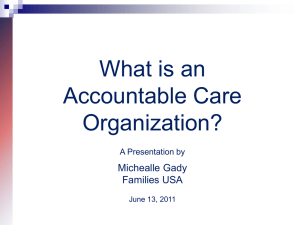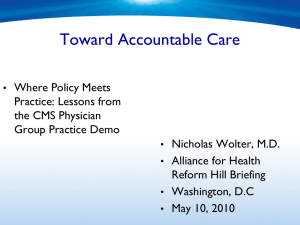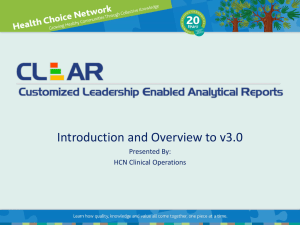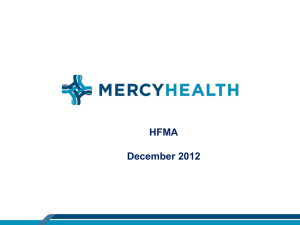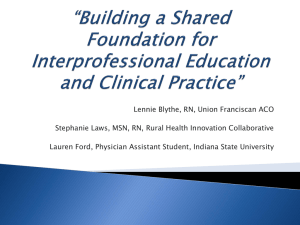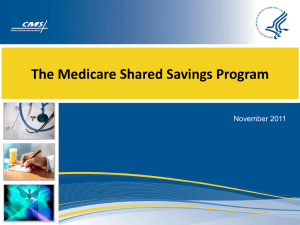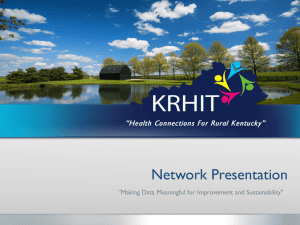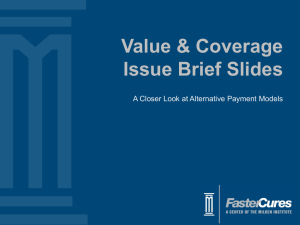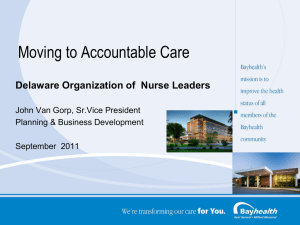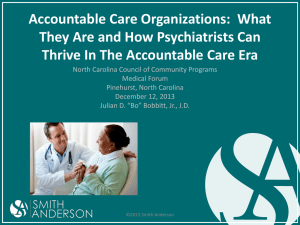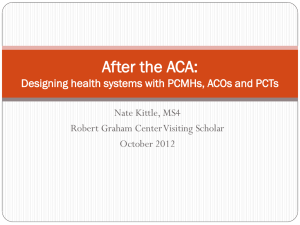Accountable Care Organizations: Perspectives from the Billings
advertisement
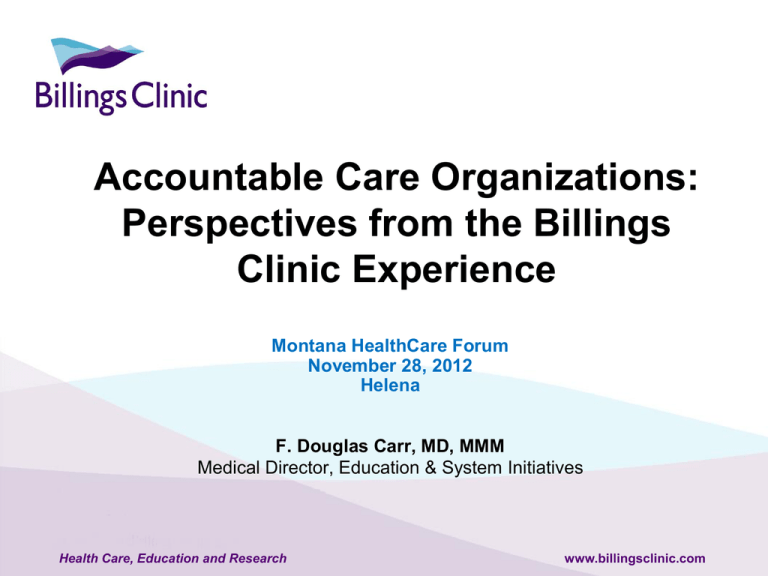
Accountable Care Organizations: Perspectives from the Billings Clinic Experience Montana HealthCare Forum November 28, 2012 Helena F. Douglas Carr, MD, MMM Medical Director, Education & System Initiatives Health Care, Education and Research www.billingsclinic.com Physician Group Practice Demonstration 2005-2010 The Alpha Medicare ACO Testing the concept that physician group practices can better coordinate care (Part A&B) than other delivery models to reduce rate of growth in percapita expenditures while improving quality Shared Savings Model: FFS continues CMS shares % of calculated savings • • • • • Types of organizations: 2 MSGP 2 AMC 5 IDS 1 PHO • Rate of growth of PGP compared to same county comparison • Individually risk adjusted (HCC) • Attribution by plurality of office visits, All-Specialty • Retrospective, blinded to both organization and beneficiary, changes yearly • Minimum Savings Threshold: 2%, Cap: 5% • Sharing is 80% only on savings >threshold but < cap • Data feedback intended on quarterly basis • 32 Quality measures (outpatient only, process + outcomes) create a gate for 50% of shared savings payment 10 Organizations Physician Group Practices Everett, WA – Everett Clinic Integrated Delivery Systems Marshfield, WI – Marshfield Clinic Springfield, MO – St Johns Danville, PA-Geisinger Billings, MT-Billings Clinic St. Louis Park, MN – Park Nicollet Winston-Salem, NC-NovantForsyth Academic Medical Center Ann Arbor, MI - University of Michigan Bedford, NH-Dartmouth Hitchcock Physician-Hospital Organization Middletown, CT – Integrated Resources for Middlesex Area (IRMA) Common Basis for Strategies among the PGP Groups 1. Focus: High Cost Areas Components of Medicare Expenditures For Billings Clinic (base year 2004) • • • • • • Inpatient Hospital OP Part B SNF Home Health DME 40% 24% 22% 7% 3% 4% Reduce avoidable admissions, ER visits, etc. 2. Focus: Chronic Care & Prevention • • • • High prevalence and high cost conditions Provider based chronic care management Care transitions Palliative care Financial Savings are INPATIENT driven. Quality Measures are OUTPATIENT driven. Heart Failure Diabetes Coronary Artery Disease Billings Clinic PGP Year 5 HTN, Screening, Prevention 5 “A detailed analysis of the demonstration is currently available only for the first two years. That analysis showed that, for patients in the 10 group practices during the 2nd year, average Medicare spending excluding the bonuses paid to physician groups was about 1 percent below projections…similar estimates are not yet available for other years…” PY1 PY2 PY3 PY4 PY5 Average Annual 5 year Expenditures Summary Results 1.21% 2.00% 2.56% 5 Year 3.63% Savings 2.37% 2.39% $218,573,184 $9,161,179,345 How The PGP (2005-2010) Influenced the Development of ACOs Transition Demo (2011-12) Accountable Care Act-2010: ACO provisions include • Primary Care Attribution • National comparison targets • Target is absolute spending increase over base • Retains risk adjustment • Incorporated changes in ACA provisions • Improved data reporting from CMS • Quality Measures 3245 • Discussions/develop ment led to first ACO proposals that ignored some PGP recs • The national consensus supported the PGP groups recommendations Final ACO Regs • Quality Measures 6533 • Eliminate 25% withhold • First Dollar sharing after minimum savings threshold • Allows for 1 or 2sided risk • Preliminary prospective assignment 10 Comparison of Shared Savings Models Attribution Base Term (before rebasing) Comparison Threshold (MSR) Savings Quality Gate Quality Measures Loss Risk Risk Adjustment PGP TD ACO Pioneer retrospective All Specialty retrospective Primary Care retrospective Primary Care retrospective Primary Care Prior Year (2004) 3 -year wt. Averaging 3-year wt. Averaging 3-year wt. Averaging 3-->5 years 2 3 3 National Absolute amount National Absolute amount National 50% amount + 50% rate growth 2% 1.47%-4.65% 2-3.9% or 2% 1% 80% above MSR 50% first dollar 50% above MSR or 60% first dollar 50% first dollar 50% 80%, 90% 100% 100% 32 45 33 33 No No No (1 sided) Yes (2 sided) Yes retrospective updated yearly prospective adjusted yearly prospective fixed for term prospective fixed for term Local Rate of growth Growth and Dispersion of Accountable Care Organizations November 2011 ACOs BY SPONSORING ENTITY “The range of entities that have sponsored ACOs, from small IPAs to national insurance companies indicates the wide range of business models that will ultimately provide accountable care.” • • • Medicare SSP has lead to commercial adoption of ACOs Market specific clustering of activity Basic tenets of accountable care previously existed; title is new “It appears, for now, that defining oneself as an ACO represents an acceptance of the direction the industry has been headed rather than an adoption of a truly new form of care delivery.” Growth and Dispersion of ACOs November 2012 Sponsorship Type Payment Shared Savings, 1 sided IDS 27 30 151 Muliple Providers Health Plan 133 36% 30% Other SS-2 sided FFS Capitation Episode/DRG Single Provider 34% 53% Many ACOs are reimbursed on a Shared Savings model based on Spending Targets ACO Launched Projected Spending Target Spending Shared Savings Actual Spending 14 15 Movement Towards ACO Raises Key Questions • What is the COST impact of delivering accountable care? • What is the REVENUE impact of delivering accountable care? 100% 90% • What is the COST impact of 80% building an ACO? 70% 60% • How do you manage the 50% hospital and physician relationship through transition to 40% 30% an ACO? 20% • How do you manage two 10% parallel entities through the 0% 0 transition? • How do you manage the pace of that transition? 16 Transition Current FFS System Accountable Care Organization n Time 16 16 The Bridge from FFS to Accountable Care Current FFS System What are the underpinning building blocks? Accountable Care ACO Core Components People Centered Foundation Health Home High Value Network Population Health Data Management ACO Leadership Payer Partnerships Foundational Philosophy: Triple Aim™ Measurement 17 17 The ACO Model A group of providers willing and capable of accepting accountability for the total cost and quality of care for a defined population. Payer Partners Insurers Employers Core Components: • People Centered Foundation • Health Home • High-Value Network • Population Health Data Mgmt • ACO Leadership • Payor Partnerships States CMS 18 Why PCMH within ACO? • Emphasizes prevention • Encourages cognition/relationship over technology • Less variation in utilization • Allows for most efficient delivery methods: allied professionals, phone, e-mail, web-enabled • Proven concept in other modern nations, staffmodel HMOs • Access closest to patients • Promotes shared decision making • Leverage point for post-hospital care Montana Patient Centered Medical Home Initiative 10-2009 • MT Medicaid received planning grant from NASHP to develop PCMH model; stakeholder discussion developed into planning for a multi-payer model • Commissioner of Securities and Insurance assumed role of facilitating discussions among MT payers and providers 10-2010 • Working group adopts NCQA Recognition as a definition standard of PCMH for Montana 5-2011 9-2011 2012 • Creation of PCMH Advisory Council sponsored by office of Insurance Commisioner • Adopted Framework for Payment as guideline for contract development • Created Uniform Quality Measure Set • Recommended the attributes of a state technology reporting platform; verified that designated HIE (Health Share Montana) meets them • Developed proposed legislation to create commission with statutory authority to develop the market rules that encourages multi-payer PCMH www.csi.mt.gov/medicalhomes BCBSMT PCMH Program • Begun in 2009 with Western Montana Clinic (St. Patrick Hospital) and Billings Clinic. • Added St. Patrick’s, CMC, Kalispell, Bozeman, and St. Vincent’s 2010-2011. Added Northern Montana Hospital and South Hills Medical Group in 2012. • Planning to add St. Peters, Benefis, Holy Rosary. • Limited to PCP providers with access to EMR. • 2009/2010: Chronic disease only. • 2011 and beyond: Chronic disease and preventative care. 21 PCMH-Physician Groups (*=active) Physician Group Number of Physicians Billings Clinic* 77 MD (16 IM, 25 FP, 18 Peds, 18 OB), 23 Midlevel Western Montana Clinic* 31 MD (8 IM, 14 FP, 5 Peds, 4 OB), 7 Midlevel St. Patrick’s Hospital* 15 MD (6 IM, 9 FP), 5 Midlevel Benefis 14 MD (7 IM, 3 FP, 4 OB), 5 Midlevel St. Peters Hospital 14 MD (2 IM, 12 FP) Kalispell Regional MC* 20 MD (3 IM, 6 IM-Peds, 11 FP), 11 Midlevel Comm. Medical Center* 20 MD (5 IM, 11 FP, 4 Peds), 7 Midlevel Bozeman Deaconess* 26 MD (9 IM, 6 FP, 6 Peds, 5 OB), 7 Midlevel Northern Montana Hosp* 10 MD (3 IM, 5 FP, 2 OB) St. Vincents* 9 MD (7 IM, 2 FP) Holy Rosary Healthcare 4 MD (1 IM, 1 FP, 2 OB) South Hills Med. Group* 2 MD (1 NP) Total Phys./Midlevels 242 MD (67 IM, 99 FP, 6 IM-Peds, 33 Peds, 35 OB), 66 Midlevel. 22 2012 BCBSMT PCMH Program Chronic Diseases Preventative Care Preventative exam Asthma Ischemic Vascular Disease Smoking status BMI BP Breast cancer screening Depression Diabetes Cervical cancer screening Colon cancer screening Immunizations 23 BCBSMT-PCMH Early Trends PCMH All other PCPs ~ 16,000 Lives ~36,000 lives Total Trend: 3.1% Total Trend 7.1% Stop-loss, excess risk adjusted Trend: 2.6% Stop-loss, excess risk adjusted Trend: 7.2% Improved documentation and reporting on quality measures • Evidence-Based Care • Prevention Status quo Blues CMO says there's 'no question' medical-home model works 11:30 am, Oct. 23 Tags: Coordinated CareMedical HomesInformation TechnologyPatient Care Without hesitation, Dr. Allan Korn, the Blue Cross and Blue Shield Association's chief medical officer and senior vice president for clinical affairs, declared that the patient centered medical home has the potential to transform the U.S. healthcare system. "The things you want going up are going up, and the things you want going down are going down," said Korn in an interview following his appearance Monday on a panel assessing the state of the healthcare industry presented in San Antonio at the MGMAACMPE's annual. "There's no question that the medical home is working, and that's what's gratifying to me." While speaking on the panel, Korn said he thinks steps could be taken to improve the patient-centeredness of the medical-home practice model. Still, he said later, medical homes—which use information technology to coordinate care and track the treatment of patients who have chronic diseases—have led to double-digit declines in patients' exposure to radiation from diagnostic tests, in "ambulatory-sensitive" hospital admissions, and in unnecessary and costly healthcare episodes. They have also boosted physician satisfaction. "When you permit a physician to perform at his or her highest level, to do what they want to do, these are things that happen," Korn said, adding that one important thing the Blues' medica- home programs have done is remove the "mother may I’s” from the practice of medicine. "We're having doctors tell us 'I'm looking forward to going to the office again.' " He added that, with some 5.3 million members covered by Blues medical homes, "we're not piloting anymore." 25 PCMH Perspectives Payer Provider Team Model best able to •Improve access •Ensure EBM care •Re-energize profession Financial risk/commitment with need for eventual ROI Assurances that a practice is transforming •Standards •Quality reporting Patients “Rules of the Road” will help •PCMH standards •Framework for payment •Quality metrics/reporting Requires Investment & Change Improved Access •IT •FTEs •Financial risk (reimbursement for nonRVU work, critical mass of pts.) Better outcomes • Prevention • EB Care Increased satisfaction Questions? 28
